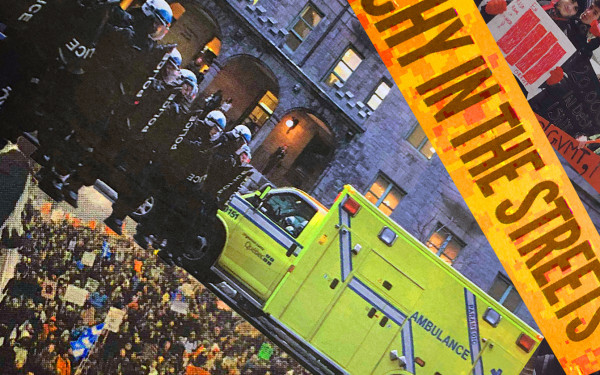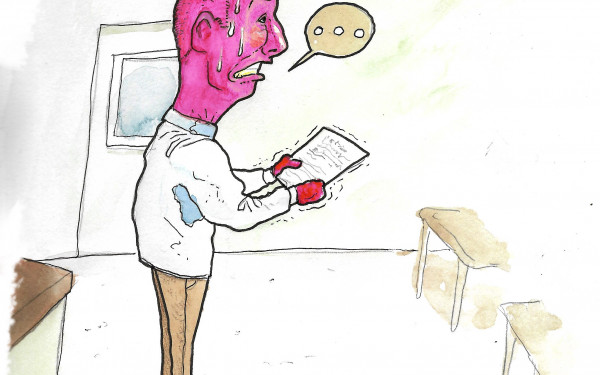Freedom of Expression in the Hands of Technology
Megaphone Gives Montrealers an Interactive Playground
Located at the Promenade des Artistes in downtown Montreal, Megaphone offers an innovative way to approach public speaking while simultaneously exploring the city’s social language.
The project, which is presented by the National Film Board of Canada and the Quartier des spectacles, is an open mic in an urban setting that welcomes local residents and visitors from different backgrounds and age groups to exchange their thoughts outdoors, while some of their words are projected onto the side of the Université du Québec à Montréal’s President-Kennedy pavilion.
“We are in a public space and people are so grateful to have this space to express themselves—they want to share that joy of being together […] and celebrating Montreal for what it is and how special [it] is,” said Louis-René Beaudin, master of ceremonies at Megaphone.
“We talk about many subjects like politics and social issues, among other things, but it’s mainly for new, positive ideas to live all together and find solutions [to] problems.”
Megaphone, also known as Agora 2.0, uses a speech recognition system designed by the Computer Research Institute of Montreal, an applied research centre. The software identifies the lexicon of Québécois French and Canadian English through phonetic transcription.
The software is activated when a person speaks through the Megaphone project’s microphone, and transcribes the speech with a 30-second delay. Select words captured by the system are then projected in a collage of nouns, verbs and adjectives onto the façade of the President-Kennedy building.
One such person’s speech was that of Gabriel Nadeau-Dubois, former co-spokesperson of the Coalition large de l’Association pour une solidarité syndicale étudiante who became one of the faces of the 2012 Quebec student protests.
“I’m the first to defend cultural diversity, and that starts with a defence of our Québécois culture,” he told the Megaphone crowd last Wednesday. “But in this regard, it’s not Islamization which should worry us, it’s Americanization. It’s not the return to religion by way of an ‘Islamic danger’ that threatens the cultures of the world: it’s their standardization by the bulldozer of Hollywood’s commodification,” he continued.
“Vincent Guzzo and [Brossard’s] Dix30 district are much more dangerous to [our] culture than a few hijabs.”
Renewing Public Consultation
Public speaking platforms already exist in other parts of the world. Freedom Park in the Philippines, for instance, offers citizens a space to gather and hold rallies and demonstrations freely without the need for a legal permit.
Similarly, the Speakers’ Corner in London, England’s Hyde Park, Hong Lim Park in Singapore and the North Shore of Wascana Lake in Regina, Saskatchewan, are permanent areas for people to express themselves in the cityscape.
In African tradition, villagers and their chiefs gathered under the shade of the palaver tree in a democratic manner in order to engage in dialogue.
Jason Prince, a professor at Concordia’s School of Community and Public Affairs and a candidate for mayor of Montreal’s Sud-Ouest borough in the upcoming municipal elections, lived in London and experienced the Speakers’ Corner there firsthand.
“We are in a public space and people are so grateful to have this space to express themselves—they want to share that joy of being together […] and celebrating Montreal for what it is and how special [it] is.”
—Louis-René Beaudin, Megaphone master of ceremonies
“These are all different ways in which citizens are engaging in a collective process of creative thinking,” he said.
He sees Megaphone, which was created by Moment Factory, a new media and entertainment studio that has worked on shows and installations around the world, as an opportunity to renew public consultation.
“Public consultations offer very formal mechanisms that do not allow for playful expression of human aspirations,” Prince said. “This place is temporary for people to come and try to get direct contact with people, to express themselves and possibly see that flow in the political space. It’s a fantastic play area.”
Activist Dan Parker, a graduate student at Concordia specializing in education, sees the Internet as an alternative gathering place.
“What we are witnessing now is an expansion of the public sphere that we’ve never [before] seen in all [of] humanity,” Parker said. “Right now everybody has access to information. Most people in industrialized countries have access to wireless Internet; most people are media literate and computer literate.
“They go on [their computers] and express themselves online, join campaigns, help people fundraise. And all of this is happening in a public sphere,” he continued.
For Parker, Megaphone is a reminder of our past.
“What is nice about the Megaphone [project] is that it’s a reminder that before, we were having a physical space, which is certainly something we’ve lost in the past,” Parker said.
But how accurate is the technology of Agora 2.0?
Voice recognition technology itself has been proven to usually be 90 to 95 per cent accurate, according to some researchers. However, Megaphone’s official website does not offer any specific information in this regard.
When a young sovereignist cheered “Vive le Québec libre!” on Friday, the program transcribed “libre” as “lir.”
According to Beaudin, the words spoken into the microphone during the duration of the project will be organized in a chart to see which were used the most.
Megaphone takes place every Wednesday to Saturday until Nov. 4.

_900_597_90.jpg)
_600_832_s.png)

_600_375_90_s_c1.jpg)

